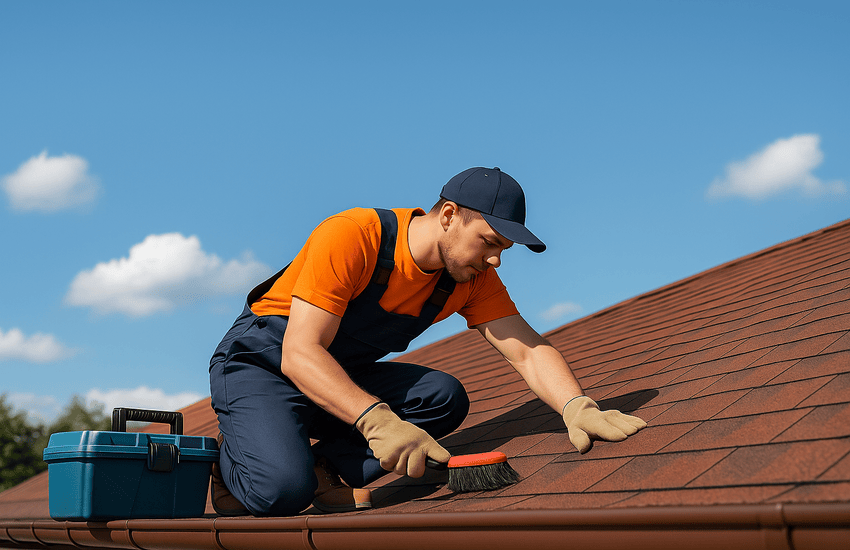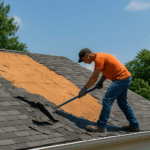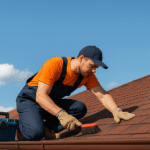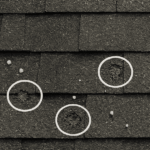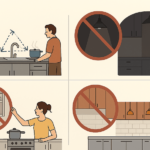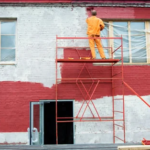The roof is very important. It’s like a shield for your home, protecting it from the sun, rain, wind, and storms. Yet, many homeowners forget about roof maintenance until a problem shows up. Regular care is the best way to avoid costly repairs and keep your roof strong for years.
That’s why, in this blog, we’ve brought you a checklist that will guide you through the most important steps of roof maintenance. Simple checks and timely fixes can make a big difference.
Ten Things to Do for Better Roof Maintenance
1. Inspect Shingles Regularly
Shingles are your roof’s first line of defense. Over time, they may crack, curl, or even go missing after strong winds. You need to look for loose or broken shingles at least twice a year.
Don’t forget to check for fresh damage after heavy storms. Damaged shingles allow water to leak into the house, causing bigger issues like mold and rot. If you find large areas with problems, it’s time to call a professional.
2. Clean Gutters and Downspouts
Homeowners often ignore the gutters, but they play a key role in protecting their roof. When gutters clog with leaves and dirt, water cannot flow away properly. This leads to water pooling on the roof or near the foundation.
Hence, you should clean your gutters at least twice a year; once in spring and again in fall. For homes with lots of trees nearby, more frequent cleaning may be needed. Downspouts should also be clear so water drains smoothly.
3. Check for Leaks and Stains
Inside your home, signs of roof problems often show up on ceilings and walls. Look for water stains, dark spots, or peeling paint. These can be signs of leaks. Remember, even a small leak can create big troubles. Over time, they weaken the structure and invite mold growth. Early detection saves money and prevents serious damage. If you notice water marks, contact a roofing expert immediately.
4. Trim Nearby Trees
Trees add beauty and shade, but branches hanging too close to your roof can be dangerous. During storms, branches can break and damage shingles. Leaves and twigs may also pile up, leading to clogged gutters.
Hence, you should trim branches so they stay at least 5 to 6 feet away from the roof. This not only reduces risks but also keeps animals like squirrels from accessing your roof.
5. Inspect Flashing Around Openings
Flashing is the thin metal used around chimneys, skylights, and vents. Its job is to seal gaps where water could enter. With time, flashing may loosen or rust, creating weak spots. Regularly check flashing during roof inspections. If you see cracks, gaps, or corrosion, repairs should be done quickly. Ignoring flashing issues often leads to leaks in hard-to-reach areas.
6. Ensure Proper Attic Ventilation
Good ventilation in the attic keeps your roof healthy. Without proper airflow, heat and moisture build up. This can shorten the life of shingles and cause wood to rot. In summer, poor ventilation makes cooling your home harder. In winter, it can lead to ice dams.
To prevent this, check if your attic feels too hot or damp. You can also add vents or fans. It may help balance airflow and protect your roof.
7. Look for Signs of Moss or Algae
Moss, algae, and mold can grow on roofs, especially in humid or shaded areas. They may look harmless at first, but they trap moisture against shingles and weaken them. Dark streaks on your roof are often a sign of algae.
You can apply a gentle cleaning solution to remove growth before it spreads. Avoid pressure washing, as it may damage shingles. For large areas, call professionals who can clean safely.
8. Schedule Professional Inspections
Even with regular checks, some roof problems are hard to see. A local professional roofer knows where to look and what to fix before issues get worse. It is wise to schedule a roof inspection once a year.
In Sachse, where hailstorms are common, inspections after major weather events are also recommended. Professionals provide peace of mind and save homeowners from costly repairs down the road.
9. Maintain Roof Sealants
Sealants are used around vents, chimneys, and flashing to keep water out. With time, sealants may crack or wear off. Check these areas regularly and reapply sealant when needed. It’s a simple step that prevents leaks and extends the life of your roof. Use high-quality materials for better protection.
10. Plan for Roof Replacement
No roof lasts forever. Asphalt shingles usually last 20–25 years, while metal and tile roofs last longer. Keep track of your roof’s age and condition. If you notice frequent repairs, sagging areas, or large patches of missing shingles, replacing the roof may be the best option. Planning ahead helps you budget and avoid emergency replacements.
Conclusion
For many homeowners, roof maintenance is like a chore, but it protects your home and your family. By following this checklist, you can avoid major issues and extend the life of your roofs. Regular inspections, simple cleaning, and timely repairs go a long way.
If you ever feel unsure about your roof’s condition, don’t wait. Call us, Oak Custom Remodeling, your trusted local experts in Sachse, Texas. Whether it’s maintenance, repairs, or full replacement, our team is ready to keep your roof strong and secure.


